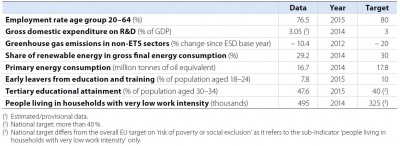Archive:Europe 2020 indicators - Denmark
- Data from June 2014. Most recent data: Further Eurostat information, Main tables. Planned article update: August 2017.
This article is part of a set of statistical articles on Europe 2020 strategy, focusing on the situation in Denmark.

Source: Eurostat, see dedicated web section: Europe 2020 indicators
Explanations on this radar chart are available here.
Main statistical findings

Source: Eurostat, see dedicated web section: Europe 2020 indicators
In 2015, Denmark exceeded its national targets on early school leavers and tertiary educational attainment, by about 2 and 8 percentage points respectively. Denmark was the only EU Member State to exceed its national R&D expenditure target of 3 % of GDP. With a 14 % reduction in primary energy consumption between 2008 and 2014, Denmark also exceeded its energy efficiency target. In 2014, the country was closer to meeting its renewable energy objective than the EU as a whole was to meeting the EU objective but lagged behind in terms of reducing its levels of GHG emissions in non-ETS sectors (2012 data). The employment rate in Denmark deteriorated slightly in the period between 2008 and 2015, widening the distance to the national target of 80 %. The number of people living in households with very low work intensity – used in Denmark as a national target in the area of poverty and social exclusion – increased by 35 % in the same time period, further enlarging the gap to the national target.
Data sources and availability
More information about the origin of the data and the calculation of indicators can be obtained via the Europe 2020 indicators dedicated website.
Under 'Tables', click on the icons next to the indicators:
- 'Explanatory texts (metadata)' for a detailed overview of the collection and compilation methods;
- 'Information on the leaf' for data availability per country.
A more general overview of quality procedures can be found in Implementation of standard reference metadata for indicators - the ESMS Indicator Profile (ESMS-IP) (PDF file).
Context
Europe 2020 is the EU’s growth and jobs strategy for the current decade, striving to pave the way to a smart, sustainable and inclusive future. The strategy envisages measures to overcome the economic crisis and move beyond it by addressing the structural weaknesses in the European economic model. The final objective is to deliver high levels of employment, productivity and social cohesion in the Member States, while reducing the impact on the natural environment.
See also
Further Eurostat information
Publications
- Smarter, greener, more inclusive - indicators to support the Europe 2020 strategy (online publication, also downloadable as PDF file)
Main tables
Dedicated section
Methodology / Metadata
- Towards robust quality management for European Statistics - Communication from the Commission COM(2011) 211 final
Other information
- Regulation (EC) No 223/2009 of 11 March 2009 on European statistics